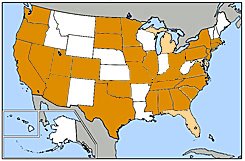Savannah, GA

When people hear that I'm a climber, they generally respond in a similar way to when they hear that I'm a middle school teacher. "Wow, you must be insane." People generally consider rock climbing to be an extremely risky endeavor. But I would argue that the seemingly conservative act of staying home on the couch is actually more risky. Hear me out...

Climbers do everything in their power to take the risk out of rock climbing. We use specialized shoes, chalk, and the info in guidebooks to minimize the chances that we will fall. We use ropes, protective hardware, and harnesses to catch us in case we do.

Lazy boys in La-Z-Boys take no such precautions. They use potato chips, various carbonated beverages, and a sedentary lifestyle, all of which endanger their very lives. As far as health and life is concerned, climbing carries an extremely miniscule short-term risk. Couching it carries a near-certain long-term risk. I know where I prefer to live. And live fully.
When teachers or administrators force kids to do “seat time” instead of participate in an active, inquisitive, and rigorous education, we are putting them at extreme and unnecessary risk. What seems like a safe bet in a climate of high-stakes testing is actually dooming our children to the educational equivalent of heart disease! Due to an imbalanced educational diet of pre-packaged junk food and overhyped red meat, their hearts are giving out after only a few years. Their hearts are literally not in it for the long haul.

Now, before I go on, I know there are still many people who think anyone who climbs has a death wish. Indeed, there are a few aspects of climbing that carry more risk than others. Every year there are a few elite climbers who keep pushing the envelope on harder climbs, in more extreme locations, with a minimal margin for error. A small handful of them never come back. But the enormous majority of climbers focus on well-protected routes that have been well developed and shared in the climbing community through researched guidebooks and word of mouth.

Newcomers to the sport usually spend months or years learning under an experienced guide on “top-rope,” a setup that insures any fall will only be a slip of a few inches. Only later will he or she begin to “lead climb,” working on more difficult routes with more intrinsic reward (and leading to bigger muscles, too!) The risk level increases slightly, but not much at all, because the safety equipment and good judgement are there. It is certainly not as risky as the certain premature death that will result from a sedentary lifestyle.

Very few climbers ever truly develop entirely new routes, instead focusing on improving their skills and repeatedly working on tough sections of routes they hope to master. There is creative expression in working to figure out how your particular climbing style and body type can successfully ascend an established route. Your partners can give you advice, and will protect you in case of a fall, but they can’t solve the problem for you. You must try, and fall, and try, and fall, and try again. As the expression goes at the crags: “If you’re not falling, you’re not improving.” You might as well just sit on the couch.

There are educators at the edge of our profession who are boldly pioneering new routes. A few of them don’t make it back, but most of these brave explorers return with glorious stories, grand adventures, and experience to share. And climbing routes that were at the cutting edge in the past are now safely accessible to average climbers who are experienced and willing to fall occasionally.
As educators, we can all push ourselves at whatever level of skill and risk that we are comfortable with. Maybe it starts with just going for a hike. Just get your butt off the couch (and certain death), grab a guide, and live a little!
Oh, and don’t forget to bring the kids.









I have to do a "thing" for the rest of the faculty at my school tomorrow. I dug out my notes from Savannah and saw your web address. I had to come check it out. Great blog!! All your tracking statistics crack me up. Thanks for all the inspiring words at the conference. Keep the enthusiasm going all across the country!
ReplyDeleteSir, your comparisons are subtle and full of depth. Thank you. If you might have a moment, could you please help me understand where my Crazy Creek chair fits into this discussion?
ReplyDeleteI cherished the importance of keeping human/thoughtful touch with the understudies and people in this season of modernized literacy.Its captivating Information share.That is amazing and dazzling. The developments happening in our world are entering every corner - as this preparation case shows up. An obligation of appreciation is all together to share this Heidi. I can simply imagine what you're shocking sublime specialist tyke will do with this extra propelling power. http://lindyfromuk.deviantart.com/art/Writing-Non-Deceptive-Marketing-Texts-602574742
ReplyDeleteCan you please send by e-mail me the code for this script or please tell me in detail concerning this script?
ReplyDeleteCertified speech language pathologist
Hello dear, are you enjoying with this humorous YouTube video? Hmmm, that’s good, I am also watching this YouTube joke video at the moment.
ReplyDeleteScience tuition